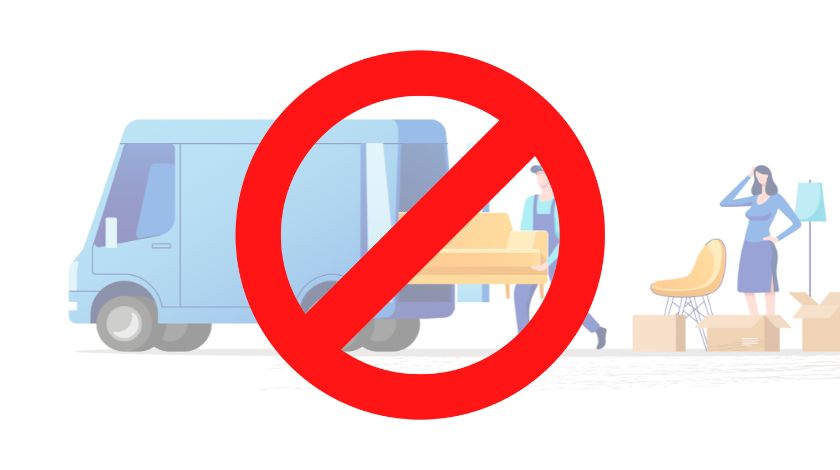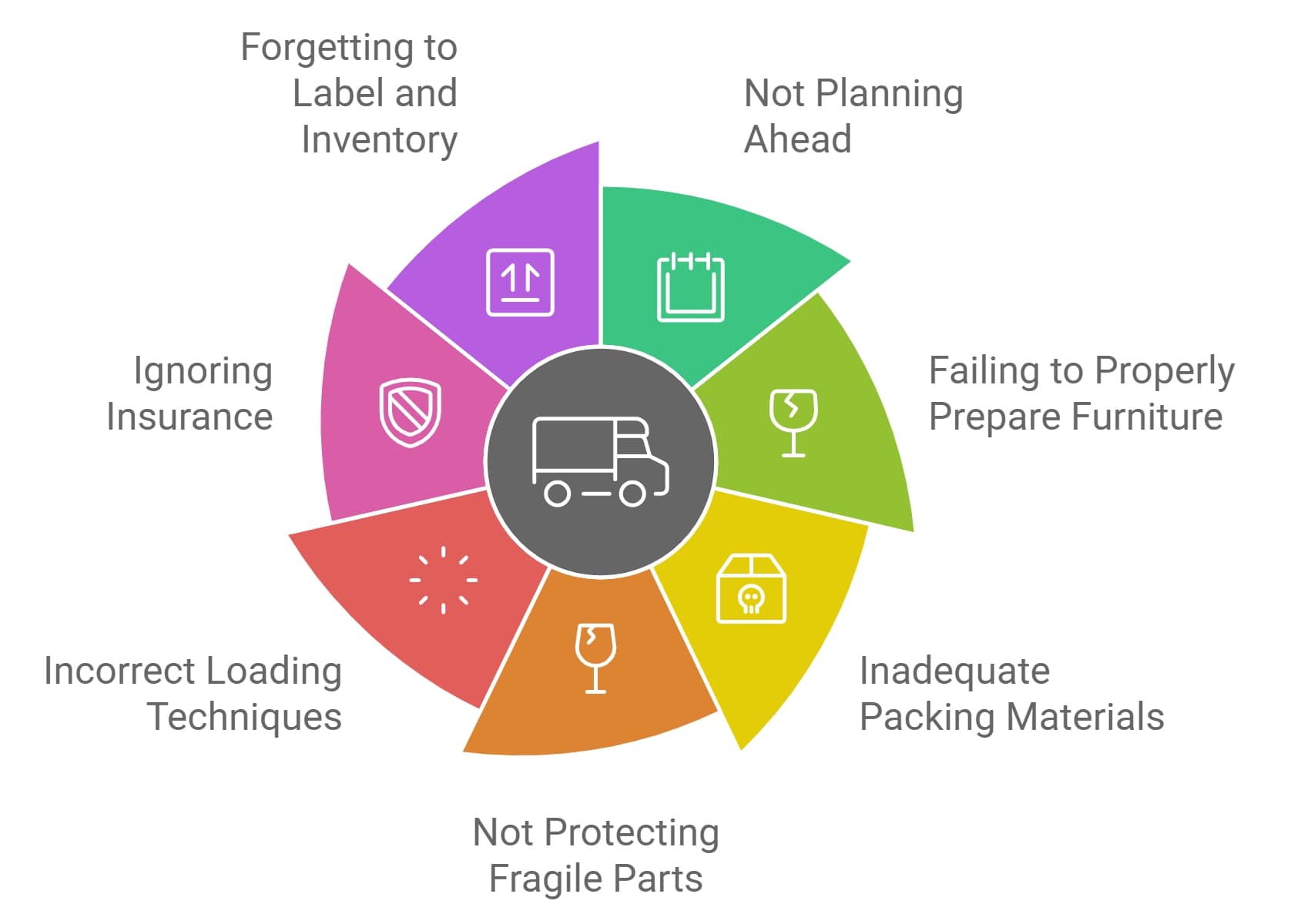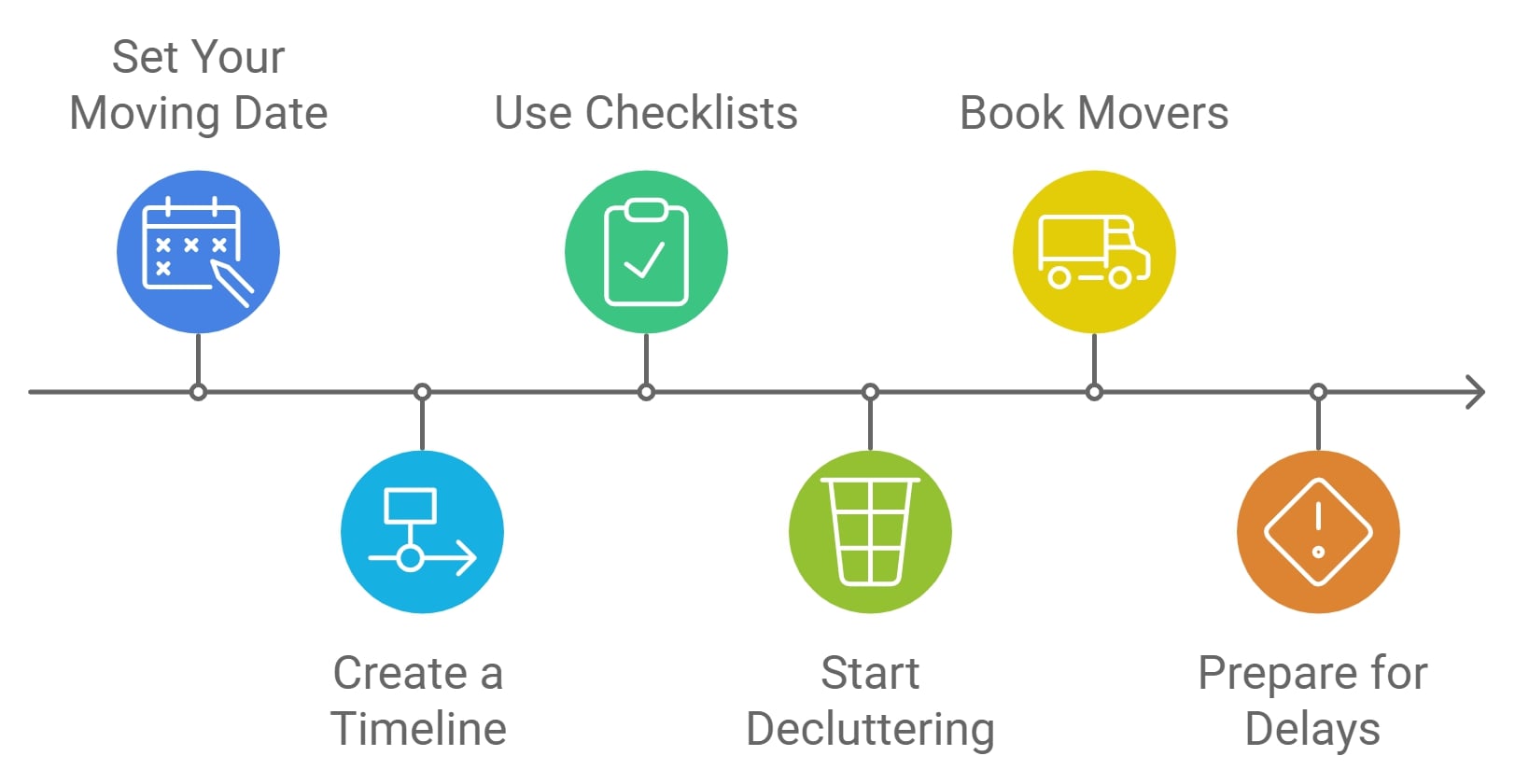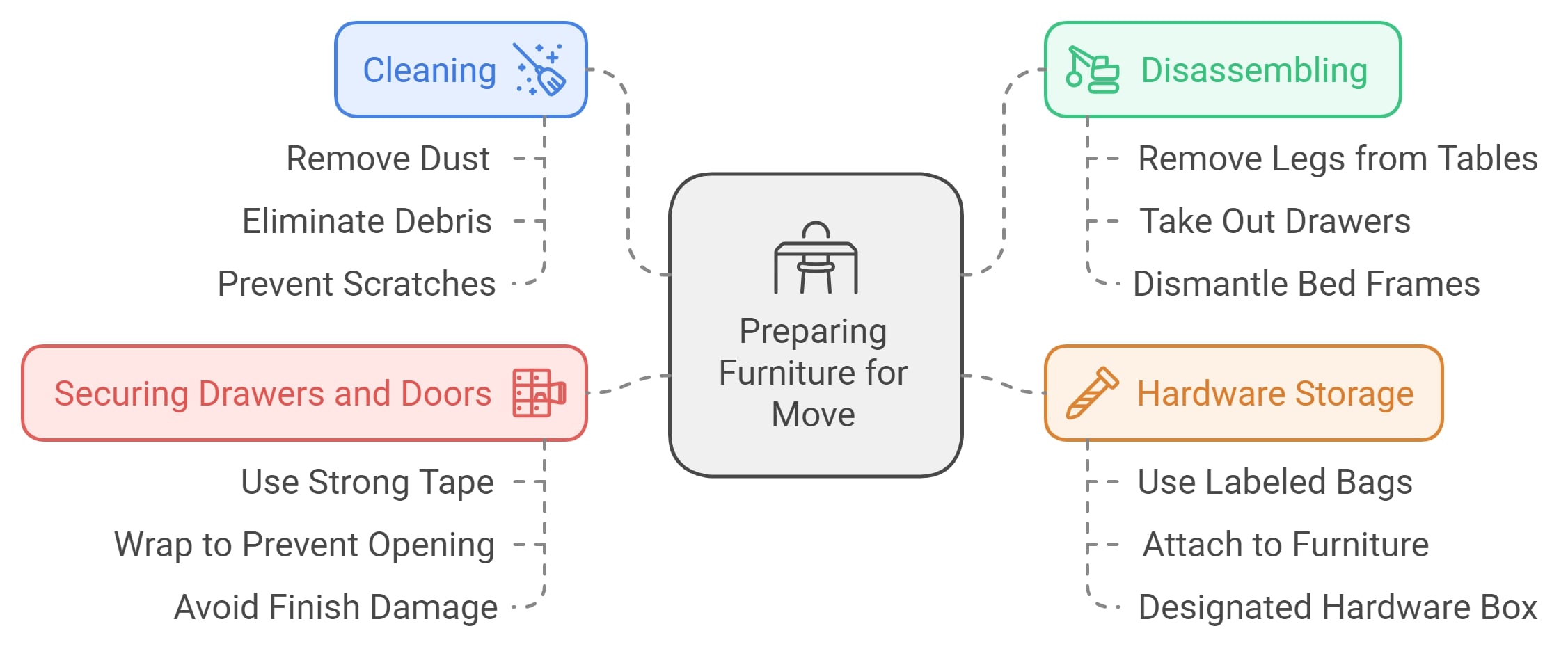7 Common Furniture Moving Mistakes and How to Avoid Them: Expert Tips

The challenges of moving bulky and often expensive items like sofas, beds, and dining sets are significant. From navigating narrow doorways to safeguarding delicate wood finishes, each step offers its own set of obstacles that can complicate your move.
In this article, we'll explore the most common issues in furniture shifting and provide practical tips to avoid them, ensuring your furniture arrives at your new home in the same condition it left. This proactive approach is your key to a smoother relocation, allowing you to enjoy your new space sooner and with much less hassle.

Mistake 1: Not Planning Ahead
One of the most detrimental errors during a move is failing to plan ahead. Last-minute planning often leads to chaotic packing, hasty decisions, and ultimately, a stressful moving day. Moreover, rushed packing can increase the risk of damage to your furniture as inadequate wrapping and protection measures are hastily applied.
Consequences of Last-Minute Planning
- Higher Costs: Last-minute bookings often come with a premium, especially during busy moving seasons.
- Limited Choices: The best moving companies may already be booked, leaving you with less reputable options.
- Increased Risk of Damage: Insufficient time to properly pack and secure furniture can lead to preventable damage during transport.
- Personal Stress: The pressure of managing a move at the eleventh hour can significantly heighten stress levels, affecting overall well-being.
Tips for Early Planning
- Create a Timeline: As soon as you know your moving date, draft a detailed timeline working backwards from the moving day. Include major tasks such as hiring movers, purchasing supplies, and packing different areas of your home.
- Use Checklists: Develop comprehensive checklists for each phase of the move. Checklists can include tasks like researching moving companies, scheduling utilities disconnections and reconnections at your new home, and finalizing real estate or rental needs.
- Start Decluttering Early: Begin sorting through your belongings weeks or even months in advance. Sell, donate, or discard items you no longer need to lighten your load and reduce moving costs.
- Book Movers in Advance: Secure a moving company as early as possible. This not only ensures you get your first choice but can also potentially lock in better rates.
- Prepare for Unexpected Delays: Allow for flexibility in your schedule to accommodate any unforeseen delays or issues. Having a buffer can reduce stress and make the move smoother.

Mistake 2: Failing to Properly Prepare Furniture
Proper preparation of your furniture before moving is crucial to prevent damage during transit. This step is often overlooked in the rush of packing and planning, but it is essential for protecting your investment in your furnishings.
Steps to Prepare Furniture for the Move
- Cleaning: Begin by thoroughly cleaning your furniture. Dust, debris, and other residues can cause scratches and stains if they're not cleaned off before wrapping and packing. Cleaning also ensures that you are moving only what is necessary and leaves behind any potential pests.
- Disassembling: Break down larger furniture items into smaller, more manageable pieces. Remove legs from tables and sofas, take out drawers from dressers, and dismantle bed frames. This not only makes the furniture easier to transport but also helps prevent damage that can occur when trying to move large, awkward items through doorways or up and down stairs.
Read more: Steps for Easy Furniture Disassembly Before Relocation
- Hardware Storage: Keep all screws, bolts, and other hardware in labeled plastic bags. Attach these bags to the piece of furniture they belong to, or keep them in a designated "hardware" box to ensure they don't get lost during the move.
- Securing Drawers and Doors: If it's not possible to remove drawers or doors, secure them with strong tape or wrap them to prevent opening during transport. Make sure the tape doesn’t touch the furniture’s finish directly to avoid damage.

Importance of Using the Right Tools for Disassembly and Packing
- Appropriate Tools: Ensure you have the right tools for disassembly. A basic toolkit that includes screwdrivers, a hammer, pliers, and an Allen wrench set is typically sufficient. Having the right tools on hand can make the process faster and prevent damage to both your furniture and the tools themselves.
- Quality Packing Materials: Invest in quality packing materials specifically designed for moving. Use bubble wrap, furniture pads, or blankets to protect furniture surfaces from scratches and dents. Stretch wrap can help keep pieces together and protect upholstery from dirt and tears.
- Proper Techniques: Learn the proper techniques for wrapping and padding your furniture. For example, never place bubble wrap directly against polished wood surfaces as it can leave marks; instead, use a moving blanket first, then overlay it with bubble wrap for additional protection.
Mistake 3: Inadequate Packing Materials
Using substandard or inappropriate packing materials when moving furniture is a common oversight that can lead to significant damage. The protection of your furniture during transit hinges greatly on the quality and suitability of the packing materials used.
Risks of Using Poor-Quality or Incorrect Packing Supplies
- Increased Damage Risk: Cheap or improper packing materials may not provide sufficient cushioning or strength, leading to scratches, dents, or breakage. For example, using thin wrapping paper instead of bubble wrap for delicate surfaces can result in damage from impacts during the move.
- Wear and Tear: Inferior quality materials like low-grade tape or thin plastic wraps can tear easily, exposing your furniture to dirt, moisture, and physical damage.
- Financial Loss: Any damage to your furniture could mean costly repairs or replacements, potentially negating any savings made from purchasing cheaper packing supplies.
Best Materials Recommended to Use for Different Types of Furniture
- Wooden Furniture: Use thick, soft blankets or moving pads to wrap wooden pieces. Secure the padding with high-quality moving tape or stretch wrap that doesn’t come in direct contact with the furniture’s surface to avoid leaving adhesive residue or causing damage.
- Glass Components: For glass tabletops, mirrors, and other fragile items, use bubble wrap followed by corrugated cardboard sheets to add an extra layer of protection. Ensure all glass items are clearly labeled as fragile.
- Upholstered Furniture: Protect couches, chairs, and other upholstered items with stretch wrap to keep dirt and moisture out. Consider covering them first with sofa covers or large sheets before applying stretch wrap to prevent moisture condensation that can lead to mold.
- Metal Parts: Prevent rust and scratches on metal furniture components by wrapping them in bubble wrap. If parts are small and detachable, they should be removed and packed separately in sealable plastic bags.
- Complex Assemblies: For furniture that involves complex assemblies (like entertainment units or custom shelving), document the disassembly process and keep all fasteners and small parts in labeled zip-lock bags. Use foam padding and bubble wrap for individual pieces, paying special attention to corners and joints.
Mistake 4: Not Protecting Fragile Parts
Furniture often includes components that are particularly vulnerable to damage during a move, such as glass elements and delicate wood finishes. Neglecting to properly protect these fragile parts can lead to costly repairs or replacements. Ensuring that these components are adequately safeguarded is crucial for a successful relocation.
Tips for Wrapping and Protecting Fragile Components of Furniture
- Use of Bubble Wrap: For any fragile components, bubble wrap should be your first line of defense. Wrap pieces multiple times, securing the bubble wrap with tape around the edges but not directly on the finish of the furniture to prevent damage.
- Soft Padding: Use moving blankets or furniture pads to add an additional layer of protection over the bubble wrap. This is particularly important for wooden furniture with intricate carvings or fragile edges.
- Secure Packing: Once wrapped, ensure that these items are securely placed in moving boxes, if small enough, or firmly secured within the moving truck to prevent shifting. Use crumpled packing paper or additional bubble wrap to fill any gaps in the boxes to keep the items from moving around during transport.
How to Secure Glass Elements and Delicate Wood Finishes
Glass Elements:
- Specialized Packing Materials: In addition to bubble wrap, consider using corrugated cardboard cut to size to protect glass surfaces. This provides a stiff shield that distributes pressure and reduces the risk of cracking or shattering.
- Edge Protectors: Use foam or cardboard edge protectors on the corners of glass tables or frames. These protectors help absorb shocks and bumps that could otherwise cause chipping or breaking.
- Labeling: Always label the packing containing glass as "Fragile - Handle with Care" to ensure that everyone involved in the move is aware of the delicate nature of the contents.
Delicate Wood Finishes:
- Furniture Covers: Use natural-fiber furniture covers or old sheets to cover wooden furniture before wrapping with bubble wrap. This layer protects the finish from getting scratched by the bubble wrap and also prevents moisture buildup, which can damage fine wood.
- Avoid Tape: Never place packing tape directly on wood finishes. If tape is necessary, ensure it only contacts the protective wrap or covers that shield the wood.
- Climate Considerations: If moving in wet or humid conditions, consider wrapping wood furniture with a plastic sheet over the blankets to protect against moisture, but only for short durations to avoid condensation buildup.
Also read: 8 Tips to Move Antique Furniture Easily and with Care
Mistake 5: Incorrect Loading Techniques
Properly loading furniture into a moving truck is critical to prevent damage during transit and ensure the safety of both the items and the individuals moving them. Incorrect loading techniques can lead to a myriad of problems, from damaged belongings to unsafe conditions for movers.
Common Errors Made During the Loading Process
- Improper Weight Distribution: One of the most common mistakes is loading the truck without considering weight distribution. Placing too much weight on one side or loading heavier items on top can cause shifting during transport, leading to damage.
- Stacking Without Strategy: Randomly stacking items can lead to crushed boxes and broken belongings. Furniture should never be placed on top of boxes that contain fragile items.
- Leaving Spaces Unfilled: Failing to fill spaces between furniture pieces can cause movement and friction during the drive, which might scratch or dent your belongings.
- Inadequate Securing: Not using straps or ropes to secure items can allow for excessive movement, particularly in a long or bumpy ride, increasing the risk of damage.
Also read: The Hidden Dangers of Moving Heavy Furniture Without Help
Proper Techniques for Loading Furniture to Avoid Damage
- Load Largest and Heaviest Items First: Start with the heaviest and largest items like sofas, refrigerators, and washing machines. Place these items against the walls of the truck to balance the load and keep them upright.
- Use Moving Blankets and Pads: Wrap all furniture in moving blankets or pads to protect surfaces from scratches and dents. Ensure that corners and edges are well padded.
- Strategically Stack Furniture: Place sturdy, box-like items (like dressers and chests) next, followed by lighter, more fragile items. Make sure each layer is level and stable before adding another.
- Fill Gaps with Soft Items: Use soft items like bags filled with clothes, linens, or pillows to fill gaps between furniture pieces. This helps prevent movement and acts as additional padding.
- Secure Everything: Once everything is loaded, use straps or ropes to secure the items to the sides of the truck. This is crucial to prevent any movement that could cause damage during transport.
- Load Last, Unload First: Place essential items or boxes you'll need immediately upon arrival at the front of the truck (near the door), so they are accessible when you arrive.
Mistake 6: Ignoring Insurance
One critical oversight many people make when moving is neglecting the need for appropriate insurance coverage. Moving can be unpredictable, and even with the best planning and execution, accidents can happen. Ensuring that you have the right insurance coverage is essential to protect against potential losses.
Understanding Insurance Options and Choosing the Right Coverage
- Variety of Options: When it comes to moving insurance, there are typically several options available, ranging from basic coverage provided by moving companies (often based on weight) to more comprehensive policies that cover the actual value of your items. It's crucial to understand what each policy covers and what it doesn't.
- Assessing Your Needs: Evaluate the value of your possessions and decide how much risk you are willing to take. If you are moving particularly valuable items, consider opting for full-value protection, which may cost more but will cover the replacement value of damaged items.
- Discuss with Movers: Always discuss insurance options with your moving company. Reliable movers should be able to explain their insurance policies and may offer upgrades for better coverage.
How Insurance Can Save You from Significant Financial Losses in Case of Damage
- Protection Against Accidents: Even with the most careful planning and handling, furniture can get damaged during a move due to unforeseen accidents. Insurance can mitigate these risks by covering repair or replacement costs.
- Peace of Mind: Knowing that your belongings are insured can give you peace of mind, making the moving process less stressful. You'll know that, should anything go wrong, you are financially protected.
- Cost-Effective in the Long Run: While paying for additional insurance might seem like an unnecessary expense initially, it can be incredibly cost-effective compared to the potential costs of replacing or repairing valuable items out of pocket.
Mistake 7: Forgetting to Label and Inventory
A common yet easily avoidable mistake during the moving process is neglecting to label and inventory your belongings properly. This step is crucial for maintaining organization throughout the move and can be invaluable in the event of damage or loss.
Benefits of Labeling Each Piece and Maintaining an Inventory
- Enhanced Organization: Labeling boxes and listing their contents helps ensure that every item has a designated place in your new home. This organized approach not only streamlines the unpacking process but also makes it easier to find specific items quickly without having to open multiple boxes.
- Efficient Unpacking: With clearly labeled boxes, you can prioritize which boxes to open first based on the rooms they belong to or the urgency of the items inside. This method significantly reduces the time and effort involved in setting up your new home.
How Labeling and Inventory Help in Organization and in Case of Any Claims
- Tracking Items: An inventory list serves as a comprehensive tracking tool that records every item you're moving. This list can be checked off as items are loaded and unloaded, ensuring that nothing gets lost or left behind.
- Quick Identification of Losses or Damage: In the unfortunate event that some of your belongings are damaged or go missing during the move, having a detailed inventory and labels makes it easier to identify and document these issues. This documentation is crucial when filing insurance claims.
- Facilitates Insurance Claims: Should you need to file a claim with your insurance company, having a detailed inventory and clear labels on your boxes can provide the necessary proof of contents and their condition before the move. This proof can help expedite the claim process and increase the likelihood of a favorable outcome.
Wrapping Up Your Move: Key Takeaways for a Damage-Free Furniture Relocation
Moving furniture involves more than just physical labor—it requires careful planning and attention to detail to ensure that everything arrives at your new home in pristine condition. We've covered key strategies to avoid common pitfalls in furniture shifting, including planning ahead, choosing the right movers, preparing your furniture properly, using the correct packing materials, protecting fragile parts, employing correct loading techniques, securing adequate insurance, and the crucial steps of labeling and inventorying your items.
Applying these tips can significantly enhance the efficiency and effectiveness of your move. By being proactive and attentive to these details, you can mitigate the risk of damage and reduce the overall stress often associated with moving.